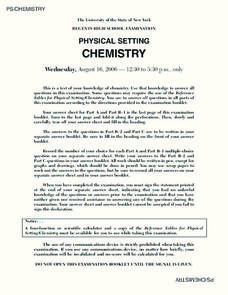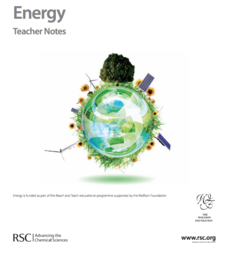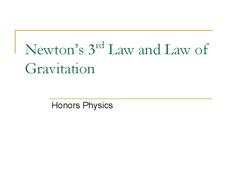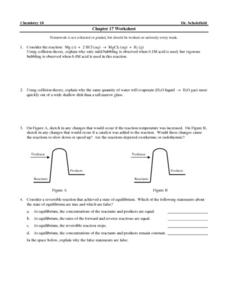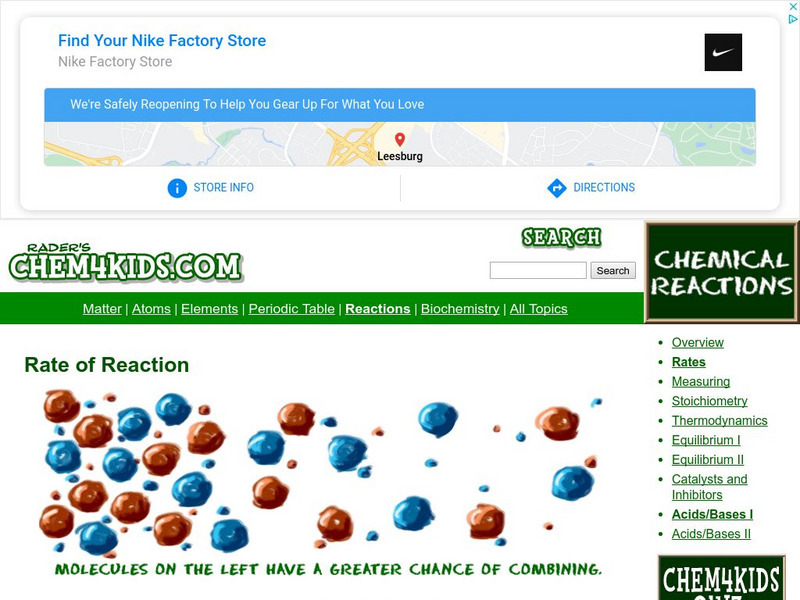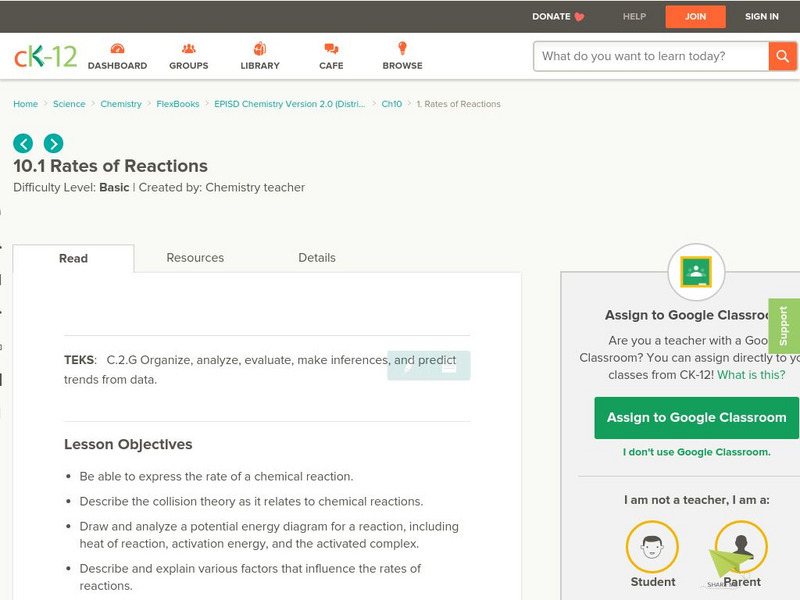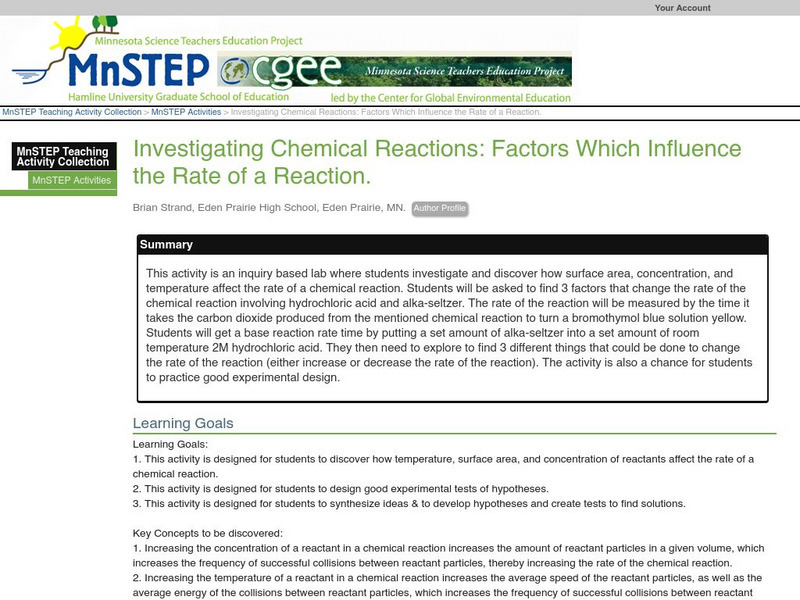Virginia Department of Education
The Rate of a Chemical Reaction
If your pupils think a catalyst is a list of their cats, then this might be the lesson for you! Young chemists study the effect of temperature, catalysts, concentration, and particle size on reaction rates during four different...
Curated OER
Regents High School Examination PHYSICAL SETTING CHEMISTRY 2006
The 2006 version of the Regents High School Exam is just as thorough as the rest of them! Assess chemistry learners on an entire year's curriculum when they take this thirteen page test.
Royal Society of Chemistry
A Solid-Solid Reaction between Lead Nitrate and Potassium Iodide
Why is it so difficult to make two solid compounds react? Investigate the concepts of particle collisions and rate of reaction using a quick demonstration. The colorful experiment features two plain, white solids combining to form a...
Royal Society of Chemistry
Energy—Gifted and Talented Chemistry
What has more energy than a room full of pupils after a fire drill? This lesson plan! Explore the changes in energy during different chemical reactions, discover why some reactions feel cold and others feel hot, and tackle the concept of...
CK-12 Foundation
Collisions
Is momentum conserved in a collision, along with energy, or are they opposing forces? Pupils vary the mass and velocity of two bumper cars along with the type of bumper in order to answer this question. Worksheet and in-simulator...
CK-12 Foundation
Bumper Cars
Is the transfer of energy different in bumper cars with stable versus bouncy bumpers? One of the variables explored in the simulation is bumper type; other variables are the mass and velocity of each car. This allows pupils to see the...
CK-12 Foundation
Crash Test Dummy
Why are car manufactures required to install seat belts and airbags; do they really make that big of a difference? Scholars use a simulator to determine the amount of force dissipated by a seat belt and airbag in a head-on crash. This is...
Discovery Education
Cushion It!
Sugar cubes, collide! Groups design protection systems using bubble wrap to protect sugar cubes from being destroyed by falling batteries in the STEM lesson. They consider how the experiment relates to collisions in real-world...
Bowels Physics
Newton's Third Law and Law of Gravitation
Why was Sir Newton so important to the field of science? Pupils discuss his contributions, specifically his Third Law, as they learn about gravity and the center of mass. They work multiple problems to ensure their understanding and...
It's About Time
Concentrating on Collisions
How important is momentum? Pupils investigate and apply the definition of momentum as they conduct analyses during a series of one-dimensional collisions. They infer the relative masses of two objects by carefully staging and predicting...
It's About Time
Conservation of Momentum
Assist your class with understanding collisions as they apply the Law of Conservation of Momentum. Pupils measure the momentum before and after manipulation of two objects so that one strikes another in an inelastic collision. The lesson...
Flipping Physics
AP Physics 1: Linear Momentum and Impulse Review
Help pupils review for the portion of the AP Physics exam that covers linear momentum and impulse review with a short video that covers an extensive amount of material.
Curated OER
Module 7 Revision Guide - Chemistry
Two versions of this handout are provided, the second with more detailed information on the same topics. Chemistry aces survey chemical reactions, heat energy transferred, and the action of enzymes by reading this resource. You can...
Curated OER
Chemistry Module 2 - Specifications
A valuable resource provides a list of concepts that young chemists should grasp. The topics include energetics, kinetics, equilibria, redox reactions, and the halogen group. Employ this as a guide for your own curriculum planning, or a...
Curated OER
Reaction Reversibility
In this reaction reversibility instructional activity, high schoolers find the equilibrium equation for a reaction of two gases and plot their concentrations over time. They answer 12 questions about the chemical reaction.
Curated OER
Chapter 17 Worksheet- Equilibrium
For this equilibrium worksheet, students answer eleven questions about chemical reactions, equilibrium concentrations and endothermic and exothermic reactions. They write equilibrium expressions for chemical reactions and they explain...
Curated OER
Reaction Kinetics and Rate Laws
In this reaction kinetics worksheet, learners draw a graph of energy vs. reaction progress and determine the factors which change the speed of a reaction. Students learn about rate laws. This worksheet has 1 graph, 15 fill in the blanks,...
Curated OER
Collision Theory Worksheet
In this reactions instructional activity, students explain why all reactions have an activation energy using their understanding of collision theory. This instructional activity has 4 short answer questions.
Georgia Department of Education
Ga Virtual Learning: Ap Chemistry: Kinetics and Equilibrium
Through interactive activities in a module format, students learn about kinetics, collision theory, reaction rates, and rate laws. They will calculate rate laws from experimental data, concentration and time, and half-life of a reaction....
Chem4kids
Chem4 Kids: Reaction Rates
This Chem4Kids.com site explores the rate of reactions. Content focuses on forces that change the speed of reactions, and measuring rates.
Concord Consortium
Concord Consortium: Molecular Workbench Showcase: Chemistry, Reactions
Simulations that can help students visualize and understand concepts in chemistry like the collision theory, chemical reaction equilibrium, and polymerization.
CK-12 Foundation
Ck 12: Rates of Reactions
[Free Registration/Login may be required to access all resource tools.] In this module, students will practice expressing the rates of chemical reactions, and they will also describe the collision theory as it relates to chemical reactions.
Chiral Publishing
Chiral Publishing: An Introduction to Chemistry: Process of Chemical Reactions [Pdf]
This chemistry chapter covers everything about chemical reactions. Read about the collision theory, rates of chemical reactions, reversible reactions, and chemical equilibrium. Many pictures and graphs will help to explain the concepts.
Science Education Resource Center at Carleton College
Serc: Investigating Chemical Reactions: Factors Which Influence Rate of Reaction
In this activity, students investigate and discover how surface area, concentration, and temperature affect the rate of a chemical reaction. This lab is designed for students to practice good experimental tests of hypotheses, synthesize...



